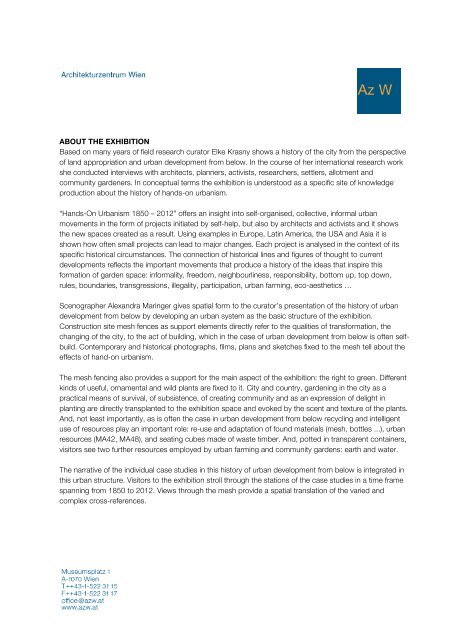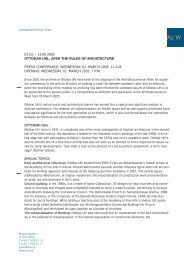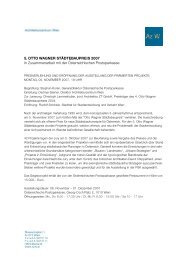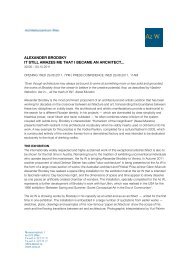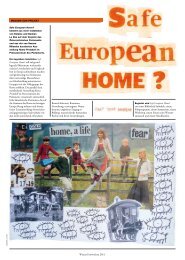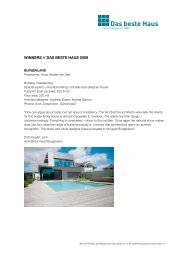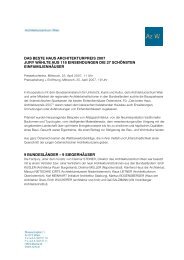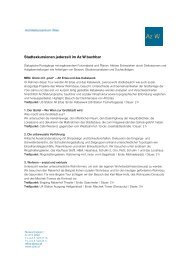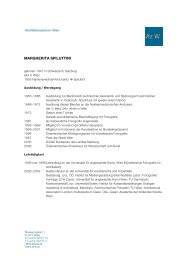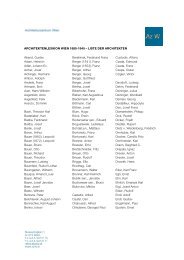Exhibition Hands-On Urbanism 1850 - Architekturzentrum Wien
Exhibition Hands-On Urbanism 1850 - Architekturzentrum Wien
Exhibition Hands-On Urbanism 1850 - Architekturzentrum Wien
Create successful ePaper yourself
Turn your PDF publications into a flip-book with our unique Google optimized e-Paper software.
ABOUT THE EXHIBITION<br />
Based on many years of field research curator Elke Krasny shows a history of the city from the perspective<br />
of land appropriation and urban development from below. In the course of her international research work<br />
she conducted interviews with architects, planners, activists, researchers, settlers, allotment and<br />
community gardeners. In conceptual terms the exhibition is understood as a specific site of knowledge<br />
production about the history of hands-on urbanism.<br />
“<strong>Hands</strong>-<strong>On</strong> <strong>Urbanism</strong> <strong>1850</strong> – 2012” offers an insight into self-organised, collective, informal urban<br />
movements in the form of projects initiated by self-help, but also by architects and activists and it shows<br />
the new spaces created as a result. Using examples in Europe, Latin America, the USA and Asia it is<br />
shown how often small projects can lead to major changes. Each project is analysed in the context of its<br />
specific historical circumstances. The connection of historical lines and figures of thought to current<br />
developments reflects the important movements that produce a history of the ideas that inspire this<br />
formation of garden space: informality, freedom, neighbourliness, responsibility, bottom up, top down,<br />
rules, boundaries, transgressions, illegality, participation, urban farming, eco-aesthetics …<br />
Scenographer Alexandra Maringer gives spatial form to the curator’s presentation of the history of urban<br />
development from below by developing an urban system as the basic structure of the exhibition.<br />
Construction site mesh fences as support elements directly refer to the qualities of transformation, the<br />
changing of the city, to the act of building, which in the case of urban development from below is often selfbuild.<br />
Contemporary and historical photographs, films, plans and sketches fixed to the mesh tell about the<br />
effects of hand-on urbanism.<br />
The mesh fencing also provides a support for the main aspect of the exhibition: the right to green. Different<br />
kinds of useful, ornamental and wild plants are fixed to it. City and country, gardening in the city as a<br />
practical means of survival, of subsistence, of creating community and as an expression of delight in<br />
planting are directly transplanted to the exhibition space and evoked by the scent and texture of the plants.<br />
And, not least importantly, as is often the case in urban development from below recycling and intelligent<br />
use of resources play an important role: re-use and adaptation of found materials (mesh, bottles ...), urban<br />
resources (MA42, MA48), and seating cubes made of waste timber. And, potted in transparent containers,<br />
visitors see two further resources employed by urban farming and community gardens: earth and water.<br />
The narrative of the individual case studies in this history of urban development from below is integrated in<br />
this urban structure. Visitors to the exhibition stroll through the stations of the case studies in a time frame<br />
spanning from <strong>1850</strong> to 2012. Views through the mesh provide a spatial translation of the varied and<br />
complex cross-references.


